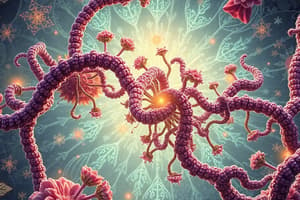Podcast
Questions and Answers
When a drug binds to its receptor, what type of change occurs?
When a drug binds to its receptor, what type of change occurs?
- Irreversible conformational change
- Reversible conformational change (correct)
- Gradual conformational change
- No conformational change
What is the term used to describe the measure of how tightly a drug binds to its target receptor?
What is the term used to describe the measure of how tightly a drug binds to its target receptor?
- Saturation
- Dose-response relationship
- Conformational change
- Affinity (correct)
What happens when a drug-receptor interaction is irreversible?
What happens when a drug-receptor interaction is irreversible?
- The drug has no effect on the receptor
- The drug forms a stable bond that persists until it is broken down by the body (correct)
- The drug-receptor complex is unstable
- The drug can leave the receptor once its therapeutic effect is accomplished
What is the relationship between drug dose and response?
What is the relationship between drug dose and response?
Why is understanding the dose-response relationship important?
Why is understanding the dose-response relationship important?
What is the term used to describe a drug that binds to a receptor but does not activate it?
What is the term used to describe a drug that binds to a receptor but does not activate it?
What is the main role of an agonist in pharmacodynamics?
What is the main role of an agonist in pharmacodynamics?
Which of the following is an example of a competitive antagonist?
Which of the following is an example of a competitive antagonist?
What is the difference between conventional agonists and inverse agonists?
What is the difference between conventional agonists and inverse agonists?
Which of the following best describes the interaction between drugs and their receptors in pharmacodynamics?
Which of the following best describes the interaction between drugs and their receptors in pharmacodynamics?
What is the main difference between competitive and noncompetitive antagonists?
What is the main difference between competitive and noncompetitive antagonists?
Which of the following is an example of a noncompetitive antagonist?
Which of the following is an example of a noncompetitive antagonist?
Flashcards are hidden until you start studying
Study Notes
Pharmacodynamics: Focusing on Agonists, Antagonists, and Drug-Receptor Binding
Agonists and Antagonists
In the realm of pharmacodynamics, agonists and antagonists play crucial roles in determining how drugs interact with their target molecules, known as receptors. These interactions ultimately lead to various physiological effects.
Agonists
Agonists are substances that bind to a receptor and promote its activation, leading to the production of a response. They can be classified as conventional agonists, which increase the proportion of activated receptors, or inverse agonists, which stabilize the receptor's inactive state, acting similar to competitive antagonists. Examples of agonists include many hormones, neurotransmitters like acetylcholine, histamine, norepinephrine, and drugs such as morphine, phenylephrine, isoproterenol, benzodiazepines, and barbiturates.
Antagonists
On the other hand, antagonists block the action of agonists by preventing them from activating the receptor. This action can be competitive, where the antagonist competes with the agonist for the same binding site, or noncompetitive, where the antagonist binds to a different part of the receptor, affecting its overall activation. Examples of antagonists include various medications such as beta-blockers and captopril.
Drug-Receiver Binding
The interaction between drugs and their receptors is essential for understanding pharmacodynamics. When a drug binds to its receptor, it undergoes a conformational change that leads to the formation of a drug-receptor complex. This binding can be reversible, allowing the drug to leave the receptor once its therapeutic effect is accomplished, or irreversible, forming a stable bond that persists until the drug is broken down by the body.
The strength of the drug-receptor interaction is determined by the drug's affinity, which refers to the measure of how tightly the drug binds to the target receptor. Higher affinity means stronger binding, leading to lower requirements for administered drug concentrations.
Dose-Response Relationship
The dose-response relationship is another critical concept in pharmacodynamics. It describes the change in response elicited by varying dosages of a particular drug. As the drug dose increases, so does its ability to bind to the receptor, eventually reaching a maximum response or saturation point. Beyond this point, further increases in dose will not significantly enhance the response. Understanding the dose-response relationship allows for optimizing drug treatment and minimizing potential side effects.
In conclusion, pharmacodynamics plays a vital role in explaining how drugs work within our bodies. By understanding concepts such as agonists and antagonists, drug-receptor binding, and the dose-response relationship, we gain valuable insights into the mechanisms behind therapeutic effectiveness and potential toxicities.
Studying That Suits You
Use AI to generate personalized quizzes and flashcards to suit your learning preferences.




